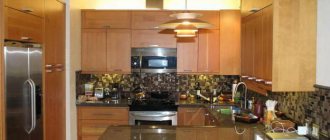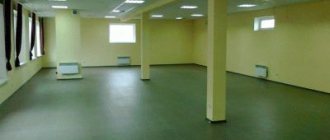More than once, a person who wants to purchase real estate from construction organizations finds a strange clarification in the documentation - the desired property is defined not as an “apartment”, but as a living space. It would seem that this is one and the same thing, but not everything is so simple. Before asking yourself the housing question, you need to figure out: living space or apartment - what is the difference and which option is best for purchasing.
“Apartment” status: what is it?
According to the Housing Code of the Russian Federation, an apartment is a separate room that is part of an apartment building. It provides access to common areas.
Such premises include entrances, elevators, playgrounds and sports grounds on the territory.
The apartment may include one or more rooms, a kitchen and an individual bathroom.
A detailed definition of the term “apartment” is presented in Article No. 16 of the second chapter of the Housing Code dated December 29, 2004.
Back to Contents
How to understand housing statuses and what they are
In fact, the differences are only in the execution of documents: in the Certificate of Ownership of the land plot on which the apartment building with premises in the status of “apartment” is located, the purpose of the land is indicated as “Land of populated areas - apartment building.” If the buyer is offered to purchase residential premises, then the Certificate of Land Title will indicate “Land of settlements - for individual housing construction or for gardening.” Both the premises and the apartment have the same purpose: residential and one can seize this property.
What does residential space mean?
The definition of “residential premises” is more extensive than the definition of an apartment. The term “residential premises” may mean the following real estate objects:
- Residential buildings and their shares/parts;
- Apartments and their individual shares;
- Rooms.
In Article No. 15 of the Housing Code of the Russian Federation, the term “residential premises” is interpreted as an isolated and habitable object. It is important that such a premises must necessarily meet the requirements of legislation and building codes.
In case of non-compliance with the requirements and rules provided by law, the premises may be recognized as unfit for living.
Back to Contents
What is a studio apartment?
If the house as a whole or a specific premises are not intended for permanent residence of citizens, such a studio is a non-residential premises - an apartment. Thus, a non-residential studio is no different from an apartment. But the residential one will differ in its purpose.
As a rule, non-residential studios are sold in residential complexes consisting entirely of apartments - non-residential premises that look similar to apartments. The price of space in an apart-hotel may be lower than in an apartment building.
But at the same time, apartments have a number of differences from apartments - from rent to taxes. In addition, apartments cannot officially serve as housing.
During their construction, some norms and rules obligatory for residential premises are not observed, and therefore it may be uncomfortable to live in them permanently. Read more about these differences here.
Key similarities and differences?
If we consider each of the objects from the point of view of their definition in the Housing Code of the Russian Federation, it may seem that there are no special differences between them. In reality, the difference between the statuses “residential premises” and “apartment” is great.
Houses where objects with apartment status are sold are built on plots of land with the appropriate purpose. The construction of the facility has been approved, a construction permit has been received, and all the necessary design documentation is available. When the completed facility is handed over, all regulatory authorities are present and communications are fully connected. Based on permission to put the house into operation, the buyer receives ownership of all objects built in the residential complex.
Houses in which “residential premises” are presented for sale are built on plots designated for individual housing construction. The developer builds a house, divides it into separate premises/rooms, puts it on the cadastre, and only after that receives the right to sell it.
As for the issue of mortgages, the difference between an apartment and a residential premises is not fundamental. Practice shows that banks are reluctant to approve a loan only if a house with residential premises is under construction. In other cases, you can even buy apartments with a mortgage, which, as you know, do not belong to residential premises.
Back to Contents
What is called an apartment?
It is one of the types of residential property. Has one or more rooms, as well as external exit. There are three types:
- Studio . As a rule, a one-room apartment with a kitchen and a bathroom.
- Country building.
- Communal . We met often in the USSR. Designed for use by several families at once. Today there are very few of these left.
You can often find phrases in advertisements such as semi-truck or unfinished property.
What does it mean? Most often, advertisements for sale without finishing suggest purchasing it in a new building. It represents objects with installed water supply and sewerage systems, installed windows and doors, and electricity supplied to the floor panel. Often without partitions between rooms and installed household appliances. The cost of such an object is much lower than a full-fledged object.
A studio is a building in which there are no partitions between rooms or even any hints of them. One continuous space instead of several rooms. This is a fairly popular type of housing in Europe. It is not yet popular in the CIS countries. Most often purchased by creative people for a recording studio, hairdresser or tattoo parlor.
A room is considered to be part of an object or residential building. Used only as a place to stay.
Are there any risks when purchasing?
An important difference between residential premises and apartments is that purchase and sale transactions for residential premises in houses under construction take place under an investment agreement, which is not protected by Federal Law No. 214, so it is very important to be completely confident in the reliability of the developer.
There are cases that people who are faced with buying a home for the first time refuse to search for real estate in the residential segment, worrying that such housing will bring a lot of worries.
In reality, there are no risks when buying a residential property. It is only important to carefully check all the documentation, make sure that a huge residential area is not being built on the site of the proposed individual housing construction, and check the developer. Back to Contents
Apartments from a legal point of view
However, no regulatory act on the “amnesty of apartments” has been adopted; a bill equating them to “housing” is promised to be submitted to the State Duma at the beginning of 2021.
It is not yet clear whether the construction of new apartments will be stopped or not.
Let's define what apartments are, they are also lofts and studios. And how do they differ from an apartment?
What are apartments
An apartment is a piece of real estate that can be either residential or non-residential.
In the current legislation of the Russian Federation there is no definition of the concept of “non-residential premises”, and even more so, the concepts of “loft”, “studio” and “apartment”.
However, the above concepts cannot be considered equivalent. In non-normative acts, the concept of “apartment” is used mainly in relation to hotel premises; the concepts of “loft” and “studio” are not mentioned anywhere at all; they are “colloquial” or “advertising” versions of apartments.
Therefore, in this article we will use the concept “apartment”, since this is what such premises are called in sales contracts related to their acquisition.
What is considered residential premises?
According to Part 2 of Article 15 of the Housing Code of the Russian Federation, an isolated premises, which is real estate and is suitable for permanent residence of citizens, is considered residential. This means that it must meet established sanitary and technical rules and regulations, and other legal requirements. That is, non-residential premises cannot be suitable for permanent residence of citizens, and therefore registration at the place of residence in them is impossible. Such premises do not meet the system of requirements that ensure the possibility of living in it.
Registration at the place of stay in non-residential premises is carried out only when the corresponding premises belong to a specialized institution, such as hotels, rest homes, hospitals; in other cases such registration in them is also impossible.
In fact, the owner will not be able to reside permanently in either the apartment, studio, or loft, although the legislation of the Russian Federation does not provide for any responsibility for permanent residence in non-residential premises owned by the right of ownership.
In addition to the differences in the technical requirements that apply to apartments and to non-residential premises suitable for temporary residence, the following differences between apartments and ordinary apartments can be identified, which are both positive and negative.
Positive differences between apartments and residential premises:
1. The cost of the apartments is significantly lower than that of apartments of comparable size. At the same time, almost all apartments are sold with an open plan, which is attractive for those buyers who are ready to design their own housing, especially since the norms of housing legislation on the reconstruction and redevelopment of residential premises do not apply to non-residential premises.
The owner of a non-residential premises has the right to carry out work on redevelopment or reconstruction of the premises without the approval of state bodies and local governments, unless the corresponding work has signs of reconstruction.
2. You can not only live in the apartments, but also equip an office and indicate their address as the legal address of the legal entity. This feature makes the apartment a sought-after investment in large cities, where people tend to live closer to work, even in the same building as their office.
3. According to the provisions of Art. 123.12, 123.13, 123.14 of the Civil Code of the Russian Federation, owners of non-residential premises can create a partnership of real estate owners (analogous to a homeowners association) for joint ownership, use and, within the limits established by law, disposal of property that is in their common ownership or for common use, as well as to achieve other goals provided for by law.
4. Usually the developer invites the owners to enter into management agreements with the Management Company, which regulate the expenses of the apartment owner for managing the building.
5. The construction of apartments is faster than the construction of residential buildings, since the developer does not need to comply with all the numerous regulations necessary for the construction and commissioning of residential buildings.
There are also significant disadvantages:
1. The costs of maintaining apartments are significantly higher than the costs of maintaining residential premises. The property tax rate for individuals in relation to non-residential premises is no more than 0.5% of their cadastral value, while the tax on residential premises cannot exceed 0.1% of their cadastral value. The cadastral value of non-residential premises can often be higher than that of similar residential premises. Currently, the Moscow Government is considering the possibility of lowering the tax rate for non-residential premises due to the increase in the cadastral value of real estate, but a final decision on this issue has not yet been made.
2. The burden of maintaining apartments is higher than that of apartment owners, since utility tariffs for non-residential premises exceed the corresponding tariffs for residential premises by up to 40%.
3. The ability of the owner of non-residential premises to use it in any way may be a disadvantage for the neighbors of such an owner. That is, some apartment residents can use them for living, and their neighbors can set up hostels and cafes in them, for example. There are practically no legal ways to prohibit your neighbors in non-residential premises from opening a hotel or hostel there.
4. Currently, residential premises under construction can only be purchased on the basis of an agreement for participation in shared construction.
You can also purchase apartments on the basis of other, including preliminary sales and purchase agreements, the terms of which are less favorable to potential buyers due to their absolute insecurity, since the legislation does not regulate the apartment market in any way, which is especially dangerous in our time, when developers are going bankrupt everywhere and more and more fraudulent schemes are being invented.
It should be noted that at the moment, as part of the bankruptcy procedure, not all courts consider it possible to recognize the right of ownership of non-residential premises in an unfinished building, since this possibility is not expressly provided for by law.
According to the Federal Law “On Insolvency (Bankruptcy)” dated October 26, 2002 N 127-FZ, all claims for recognition of ownership rights against a developer in respect of whom an arbitration court has introduced a monitoring procedure are considered as part of the bankruptcy procedure.
This means that once the monitoring procedure is introduced, it will no longer be possible to file a claim in a court of general jurisdiction at the location of the property. If the recognition of ownership of non-residential premises is refused, all premises will be transferred to the bankruptcy estate and sold during the bankruptcy process, and the buyer of the apartments can only demand the return of the money paid.
Therefore, even before the introduction of surveillance against the developer, it is necessary to have time to recognize the ownership of non-residential premises in a court of general jurisdiction in order to avoid a possible refusal to recognize the ownership right in an arbitration court.
5. In relation to the sale of apartments, it is practiced to conclude preliminary sales and purchase agreements, which have a number of nuances. This is due to the fact that a purchase and sale agreement can only be concluded for non-residential premises that have already been built and duly registered, and an equity participation agreement is simply not beneficial for the developer, since its conclusion is regulated in detail by current legislation, imposing certain obligations on the developer.
A preliminary agreement is not subject to mandatory state registration , like an agreement on shared participation in construction, therefore the same apartment can be “sold” under a preliminary agreement to several buyers, and this fact cannot be verified. In addition, when concluding a preliminary agreement, the developer is not required to enter into an insurance contract against failure to fulfill obligations to transfer the premises to the buyer.
Unfortunately, many preliminary agreements do not indicate the exact period when the main purchase and sale agreement must be concluded with the transfer of the premises to the owner, which is a big problem for potential buyers. Most often, this period depends on the registration of the developer’s ownership of the premises, that is, it is not a predetermined date, but depends entirely on when the developer submits the relevant documents to Rosreestr. Sometimes such agreements indicate a date no later than which the purchase and sale agreement must be concluded.
The legal consequence of not concluding a purchase and sale agreement before the expiration of the period specified in the preliminary agreement is the termination of the preliminary purchase and sale agreement, that is, the termination of the developer’s obligations to transfer ownership of the premises to the buyer, since in accordance with clause 6 of Art. 429 of the Civil Code of the Russian Federation, the obligations provided for by the preliminary agreement are terminated if, before the end of the period within which the parties must conclude the main agreement, it is not concluded or one of the parties does not send the other party an offer to conclude this agreement.
Therefore, in order to prevent the consequences of missing the specified period, an application for concluding the main purchase and sale agreement should be sent to the developer shortly before the expiration of the specified period. If, before the expiration of the period specified in the preliminary agreement, the purchase and sale agreement has not been concluded, and the application for the conclusion of the agreement has not been sent to the developer, the latter only has obligations to return the funds received, the right to recognize ownership of the apartment will be lost.
6. The procedure for converting non-residential premises into residential premises is quite complex. At the moment, the procedure and the list of documents required for this are described in detail in the Administrative Regulations for the provision of state documents, approved by Decree of the Moscow Government of October 27, 2015 N 692-PP.
Taking into account the above “disadvantages”, the high costs of maintaining an apartment, if you purchase it for further living in it, it makes sense, after all, to transfer it to the status of “residential premises”, which, however, will not prevent neighbors from renting out their apartment in quality of hotel rooms.
What is the difference between a building and a room?
Building and premises are terms that are often used in construction and in legal descriptions of housing issues. In fact, these are words denoting completely different objects . A building is usually called a structure that has components as premises. The room, in turn, is part of the building, its functional feature. Depending on the purpose, the building may differ in purpose, just like the premises - to be residential or non-residential.
Real EstateComment
What is a building?
A building is a ground-type structure that has a specific design and internal space . Such an object is intended for living, working or for use for industrial technical needs.
Building
The terminology excludes the meaning of a building as buildings that lack internal space. It is incorrect to call overpasses, bridges, cooling towers, above-ground and underground structures, tunnels, and dams buildings. They relate to structures for technical and industrial purposes.
The results of the work of builders are usually called the term “building”. Distinctive parameters are considered to be the presence of:
- Volumetric parameters of architectural design.
- The presence of an above-ground part.
- Presence of an underground part.
- Internal room type.
- Availability of networks and communications.
There is also a certain structure of the building, which implies the existence of elements:
- Premises . They are formed by zoning the internal space of the building by erecting wall partitions.
- Basement . It is a floor that is located in the fundamental area of the building.
- Ground floor . Involves location in the blind area of the building.
- Ground floor , located above the building's horizon level.
- The attic space is located in front of the roof, at the very top of the building.
- Attic . It is a room that has been put into operation under the ceilings of a pitched or gable roof.
- Technical floor . Provides an area where the entire communication sphere of the building is concentrated.
The number of floors in a room depends on the level of location above the horizon line, calculated when carrying out design work.
Modern buildings
Expert opinion
Marianna Shmigirilova : The criteria for issuing loans to objects have become stricter for all market objects in principle. Since multi-apartment residential buildings have a project and a building permit, of course, it is easier for them to cooperate with banks. Residential premises are smaller objects, these are low-rise buildings, it is more difficult for them to compete in the market with apartment buildings. We can say that the requirements for everyone have increased, but it has become more difficult for residential premises to compete in relation to apartments.
We recommend reading: New benefits for labor veterans in Tyumen from February 1, 2021





